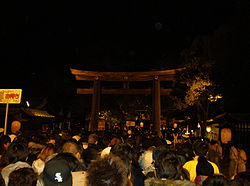
Hatsumode
Encyclopedia

Jinja (Shinto)
A Shinto shrine is a structure whose main purpose is to house one or more Shinto kami....
visit of the New Year in Japan
Japanese New Year
The is one of the most important annual festivals, with its own unique customs, and has been celebrated for centuries. Due to the importance of the holiday and the preparations required, the preceding days are quite busy, particularly the day before, known as Ōmisoka.The Japanese New Year has been...
. Some people visit a Buddhist temple instead. Many visit on the first, second, or third day of the year as most are off work on those days. Generally, wishes for the new year are made, new o-mamori (charms or amulet
Amulet
An amulet, similar to a talisman , is any object intended to bring good luck or protection to its owner.Potential amulets include gems, especially engraved gems, statues, coins, drawings, pendants, rings, plants and animals; even words said in certain occasions—for example: vade retro satana—, to...
s) are bought, and the old ones are returned to the shrine so they can be burned. There are often long lines at major shrines throughout Japan
Japan
Japan is an island nation in East Asia. Located in the Pacific Ocean, it lies to the east of the Sea of Japan, China, North Korea, South Korea and Russia, stretching from the Sea of Okhotsk in the north to the East China Sea and Taiwan in the south...
.
Most Japanese are off work from December 29 until January 3. It is during this time that the house is cleaned, debts are paid, friends and family are visited and gifts are exchanged. It would be customary to spend the early morning of New Year's Day in domestic worship, followed by sake—often containing edible gold
Gold
Gold is a chemical element with the symbol Au and an atomic number of 79. Gold is a dense, soft, shiny, malleable and ductile metal. Pure gold has a bright yellow color and luster traditionally considered attractive, which it maintains without oxidizing in air or water. Chemically, gold is a...
flakes—and special celebration food. During the hatsumōde, it is common for men to wear a full kimono
Kimono
The is a Japanese traditional garment worn by men, women and children. The word "kimono", which literally means a "thing to wear" , has come to denote these full-length robes...
—one of the rare chances to see them doing so across a year. The act of worship is generally quite brief and individual and may involve queuing at popular shrines. The o-mamori vary substantially in price.
Some shrines and temples have millions of visitors over the three days. Meiji Jingū
Meiji Shrine
', located in Shibuya, Tokyo, is the Shinto shrine that is dedicated to the deified spirits of Emperor Meiji and his wife, Empress Shōken.-History:...
for example had 3.45 million visitors in 1998, and in the first three days of January 2010, 3.2 million people visited Meiji Jingū, 2.98 million Narita-san
Narita-san
Narita-san Shinshō-ji is a Shingon Buddhist temple located in central Narita, Chiba, Japan. It was founded in 940 by Kanchō Daisōjō, a disciple of Kōbō Daishi...
, 2.96 million Kawasaki Daishi
Kawasaki Daishi
is the informal name of in Kawasaki, Japan. Founded in 1128, it is the headquarters of the Chizan sect of Shingon Buddhism. Kawasaki Daishi is a popular temple for hatsumōde . In 2006, 2.72 million people engaged in hatsumōde here, the third largest figure in Japan and the largest in Kanagawa...
, 2.7 million Fushimi Inari Taisha, and 2.6 million Sumiyoshi Taisha
Sumiyoshi Taisha
, also known as Sumiyoshi Grand Shrine, is a Shinto shrine in Sumiyoshi ward in the city of Osaka, Japan. It is the main shrine of all the Sumiyoshi shrines in Japan...
. Other popular destinations include Atsuta Jingū, Tsurugaoka Hachiman-gū, Dazaifu Tenman-gū
Dazaifu Tenman-gu
is a Shinto shrine in Dazaifu, Fukuoka Prefecture, Japan. It is built over the grave of Sugawara no Michizane and is one of the main shrines dedicated to Tenjin, the deified form of Michizane....
, and Hikawa Jinja.
A common custom during hatsumōde is to buy a written oracle
Oracle
In Classical Antiquity, an oracle was a person or agency considered to be a source of wise counsel or prophetic predictions or precognition of the future, inspired by the gods. As such it is a form of divination....
called omikuji
Omikuji
Omikuji are random fortunes written on strips of paper at Shinto shrines and Buddhist temples in Japan. Literally "sacred lot", these are usually received by making a small offering and randomly choosing one from a box, hoping for the resulting fortune to be good...
. If your omikuji predicts bad luck you can tie it onto a tree on the shrine grounds, in the hope that its prediction will not come true. The omikuji goes into detail, and tells you how you will do in various areas in your life, such and business and love, for that year. Often a good-luck charm comes with the omikuji when you buy it, that will summon good luck and money your way.

